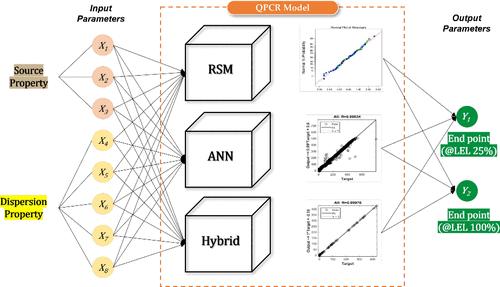利用响应面法和人工神经网络方法开发用于预测氢气泄漏和扩散的定量属性-后果关系模型
IF 3.7
3区 化学
Q2 CHEMISTRY, MULTIDISCIPLINARY
引用次数: 0
摘要
氢气是一种环保且备受推崇的未来能源,但泄漏后会形成易燃的蒸汽云,并有可能演变成爆炸。预测氢气的扩散行为对于防止此类事件的发生至关重要。本研究旨在利用响应面法(RSM)和人工神经网络(ANN)建立一个定量属性-后果关系(QPCR)模型,以快速准确地预测氢气的扩散行为。最初,从源和扩散模型中定义了 8 个变量,通过 6,561 次 PHAST 模拟构建了数据集。随后,根据方差分析(ANOVA)排除了四个影响较小的变量后,建立了 RSM-BBD(方框-贝肯设计)和 ANN-BPNN(反向传播神经网络)模型,以及一个包含 BPNN 的混合模型。所有模型的 R2 值均超过 0.99。与 ANN-BPNN 相比,混合模型显著降低了 97% 的计算成本,并表现出较低的均方误差 (MSE)。这些结果为高精度 QPCR 建模引入了一种经济有效的方法,并凸显了多种统计方法的可行性。本文章由计算机程序翻译,如有差异,请以英文原文为准。

Development of the Quantitative Property–Consequence Relationship Model for Prediction of Hydrogen Leakage and Dispersion Using Response Surface Method and Artificial Neural Network Approaches
Hydrogen, an environmentally friendly and highly regarded future energy source, can form flammable vapor clouds upon leakage, which may transition into explosion. Predicting the dispersion behavior of hydrogen is crucial for preventing such incidents. This study aims to develop a quantitative property–consequence relationship (QPCR) model using the response surface method (RSM) and artificial neural network (ANN) to swiftly and accurately predict dispersion behavior. Initially, 8 variables were defined from source and dispersion models, constructing a data set through 6,561 PHAST simulations. Subsequently, the RSM-BBD (Box-Behnken design) and ANN-BPNN (Backpropagation neural network) models were developed, alongside a hybrid model incorporating BPNN after excluding four low-influence variables based on analysis of variance (ANOVA). All models achieved an R2 value exceeding 0.99. The hybrid model notably reduced computational costs by 97% compared to ANN-BPNN and exhibited lower mean square error (MSE). These results introduce a cost-effective approach for high-accuracy QPCR modeling and highlight the viability of diverse statistical methods.
求助全文
通过发布文献求助,成功后即可免费获取论文全文。
去求助
来源期刊

ACS Omega
Chemical Engineering-General Chemical Engineering
CiteScore
6.60
自引率
4.90%
发文量
3945
审稿时长
2.4 months
期刊介绍:
ACS Omega is an open-access global publication for scientific articles that describe new findings in chemistry and interfacing areas of science, without any perceived evaluation of immediate impact.
 求助内容:
求助内容: 应助结果提醒方式:
应助结果提醒方式:


